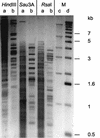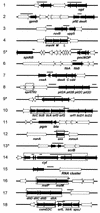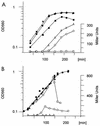The Streptococcus pneumoniae cia regulon: CiaR target sites and transcription profile analysis
- PMID: 12486041
- PMCID: PMC141814
- DOI: 10.1128/JB.185.1.60-70.2003
The Streptococcus pneumoniae cia regulon: CiaR target sites and transcription profile analysis
Abstract
The ciaR-ciaH system is one of 13 two-component signal-transducing systems of the human pathogen Streptococcus pneumoniae. Mutations in the histidine protein kinase CiaH confer increased resistance to beta-lactam antibiotics and interfere with the development of genetic competence. In order to identify the genes controlled by the cia system, the cia regulon, DNA fragments targeted by the response regulator CiaR were isolated from restricted chromosomal DNA using the solid-phase DNA binding assay and analyzed by hybridization to an oligonucleotide microarray representing the S. pneumoniae genome. A set of 18 chromosomal regions containing 26 CiaR target sites were detected and proposed to represent the minimal cia regulon. The putative CiaR target loci included genes important for the synthesis and modification of cell wall polymers, peptide pheromone and bacteriocin production, and the htrA-spo0J region. In addition, the transcription profile of cia loss-of-function mutants and those with an apparent activated cia system representing the off and on states of the regulatory system were analyzed. The transcript analysis confirmed the cia-dependent expression of seven putative target loci and revealed three additional cia-regulated loci. Five putative target regions were silent under all conditions, and for the remaining three regions, no cia-dependent expression could be detected. Furthermore, the competence regulon, including the comCDE operon required for induction of competence, was completely repressed by the cia system.
Figures






References
-
- Aaberge, I. S., J. Eng, G. Lermark, and M. Lovik. 1995. Virulence of Streptococcus pneumoniae in mice: a standardized method for preparation and frozen storage of the experimental bacterial inoculum. Microb. Pathog. 18:141-152. - PubMed
-
- Alloing, G., C. Granadel, D. A. Morrison, and J.-P. Claverys. 1996. Competence pheromone, oligopeptide permease, and induction of competence in Streptococcus pneumoniae. Mol. Microbiol. 21:471-478. - PubMed
-
- Alloing, G., B. Martin, C. Granadel, and J.-P. Claverys. 1998. Development of competence in Streptococcus pneumoniae: pheromone autoinduction and control of quorum sensing by the oligopeptide permease. Mol. Microbiol. 29:75-83. - PubMed
-
- Bartilson, M., A. Marra, J. Christine, J. S. Asundi, W. P. Schneider, and A. E. Hromockyj. 2001. Differential fluorescence induction reveals Streptococcus pneumoniae loci regulated by competence stimulator peptide. Mol. Microbiol. 39:126-135. - PubMed
Publication types
MeSH terms
Substances
Associated data
- Actions
- Actions
LinkOut - more resources
Full Text Sources
Other Literature Sources

